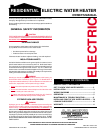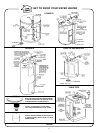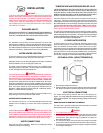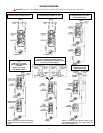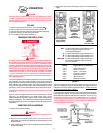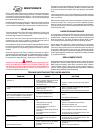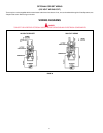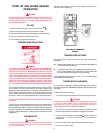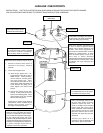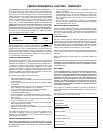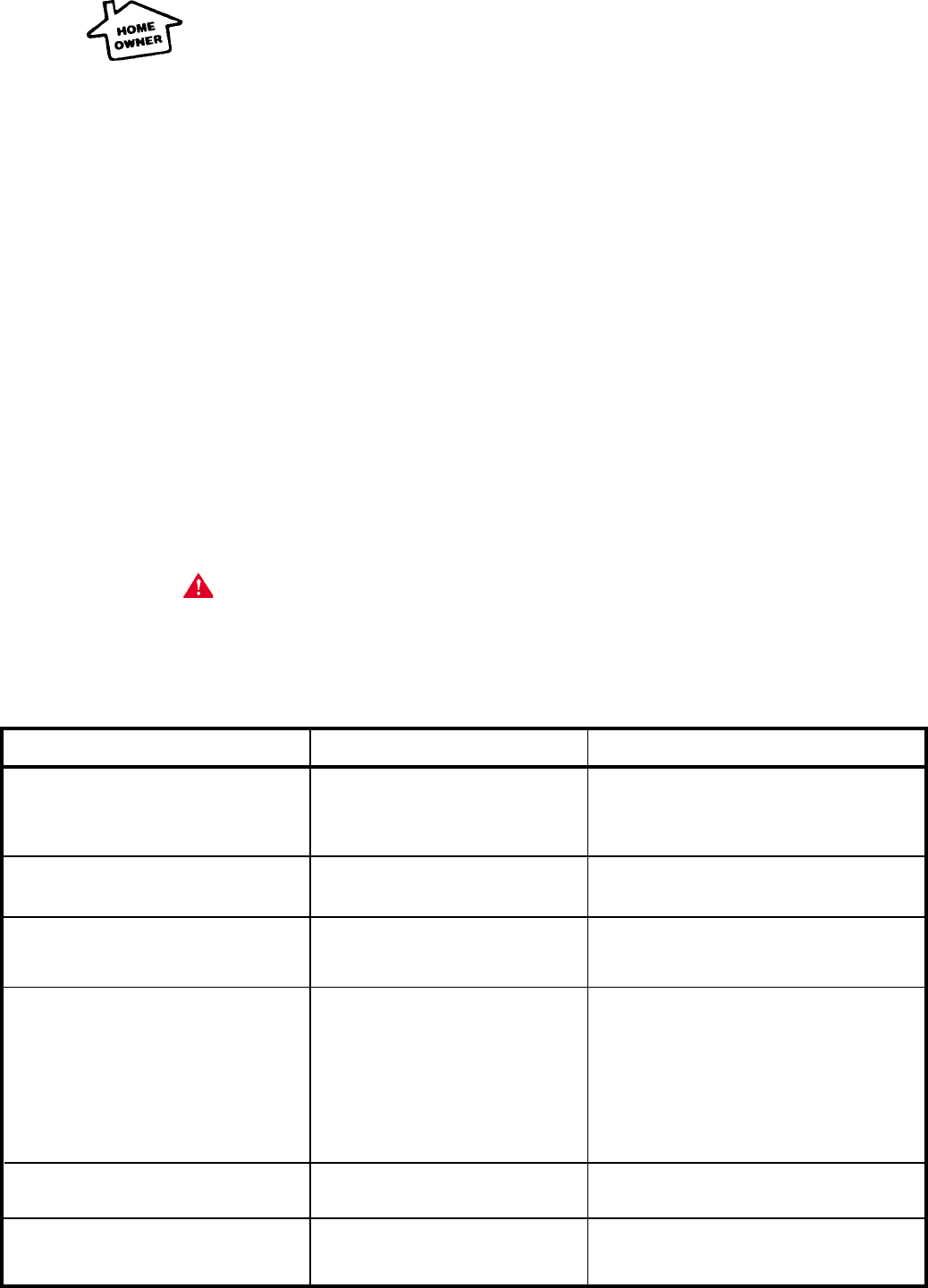
6
MAINTENANCE
Electric water heater maintenance consists of cleaning the tank bottom
and removing scale from the heating elements. Your dealer should be
contacted for tank and element cleaning. In some instances a hissing
sound may be heard as the scale builds up. This noise is normal although
the scale should be removed.
Periodically the temperature and pressure relief valve should be checked
to insure that it is in operating condition. Lift the lever at the top of the
valve several times until the valve seats properly and operates freely.
RELIEF VALVE
The temperature/pressure (T&P) relief valve is rated at 210°F (99°C) and
150 psi (1034kPa). This valve is a safety device to protect against
abnormally high temperature and pressures.
Never remove T&P valve from the tank and reinstall in the drain line. If
replacement of the valve is needed, it must be replaced with the
recommended valve and installed in its original location.
If the temperature/pressure relief valve discharges periodically, this may
be due to thermal expansion in a closed water supply system. Contact
the water supplier or local plumbing inspector on how to correct this
situation.
A thermal expansion tank may be needed to allow water to expand.
Expansion tanks are available from A.O. Smith Water Products Company,
5621 W. 115th Street, Alsip, IL 60803. Inspect the unit for proper operation.
Do not ignore the water discharge. Never plug the T&P relief valve.
DANGER
DANGER OF PERSONAL INJURY FROM SCALDING. WATER FROM T&P
RELIEF VALVE MAY BE EXTREMELY HOT AND IS NOT TEMPERED. USE
EXTREME CAUTION WHEN DISCHARGING VALVE. REPLACEMENT OF
T&P VALVE SHOULD BE DONE BY A TRAINED PROFESSIONAL OR A
LICENSED PLUMBING CONTRACTOR.
At least once a year, the temperature and pressure relief valve must be
checked to ensure that it is in operating condition. Lift the lever at the top
of the valve several times until the valve seats properly and operates
freely.
If water does not flow, valve may be obstructed or corroded. Remove
valve and inspect for corrosion. Have it replaced with the recommended
valve if necessary.
Removal and inspection of the valve should be done every three years.
Do not try to repair valve. Doing so will result in improper operation
which may result in a tank explosion. In areas with poor water conditions,
it may be necessary to remove and inspect the T&P valve more often
than every three years.
ANODE ROD MAINTENANCE
The anode rod is used to protect the tank from corrosion. Water tanks
are equipped with an anode rod. The submerged rod sacrifices itself to
protect the tank. Instead of corroding the tank, water ions attack and eat
away the anode rod. This does not affect the water's taste or color.
The rod must be maintained to keep the tank in operating condition.
Anode deterioration depends on water conductivity, not necessarily
water condition. It may be necessary to have the anode rod inspected
a few times during the first year to see what effect the water has had.
A corroded or pitted anode rod, in the first year, indicates high water
conductivity and should be checked and or replaced more often than an
anode rod that appears to be fairly clean. Inspection should be conducted
by a qualified technician.
REPLACEMENT PARTS
Replacement parts may be ordered through dealers, authorized servicers
or distributors. Refer to Yellow Pages for where to call or contact the
Water Products Company, 5621 West 115th Street, Alsip, IL 60803,
1-800-433-2545. When ordering parts, specify complete model no.,
serial no., (see rating plate), quantity and name of part desired. Standard
hardware items should be purchased locally.
TROUBLE SHOOTING ELECTRIC WATER HEATERS
CAUSE
IMPROPERLY SEALED HOT OR COLD
SUPPLY CONNECTIONS, RELIEF VALVE
OR THERMOSTAT THREADS
LEAKAGE FROM OTHER APPLIANCES
OR WATER LINES
THERMAL EXPANSION IN CLOSED
WATER SYSTEM
IMPROPERLY SEATED VALVE
HIGH SULFATE OR MINERAL
CONTENT IN WATER SUPPLY
BACTERIA IN WATER SUPPLY
POWER SUPPLY TO HEATER IS NOT
ON
THERMOSTAT SET TOO LOW
HEATER UNDERSIZED
INCOMING WATER IS UNUSUALLY
COLD (WINTER)
LEAKING HOT WATER FROM PIPES OR
FIXTURES
HIGH TEMPERATURE LIMIT SWITCH
ACTIVATED
THERMOSTAT SET TOO HIGH
HIGH TEMPERATURE LIMIT SWITCH
ACTIVATED
SCALE ACCUMULATION ON ELEMENTS
SEDIMENT BUILD-UP ON TANK
BOTTOM
SOLUTION
TIGHTEN THREADED CONNECTIONS
INSPECT OTHER APPLIANCES NEAR WATER
HEATER
INSTALL THERMAL EXPANSION TANK (DO NOT
PLUG T & P RELIEF VALVE)
CHECK RELIEF VALVE FOR PROPER OPERATION
DRAIN AND FLUSH HEATER THOROUGHLY, AND
REFILL
CHLORINATE WATER SUPPLY
TURN DISCONNECT SWITCH ON OR CONTACT
ELECTRICIAN
REFER TO TEMPERATURE REGULATION
REDUCE HOT WATER USE
ALLOW MORE TIME FOR HEATER TO REHEAT
HAVE PLUMBER CHECK AND REPAIR LEAKS
CONTACT DEALER TO DETERMINE CAUSE: SEE
TEMPERATURE REGULATION
REFER TO TEMPERATURE REGULATION
CONTACT DEALER TO DETERMINE CAUSE: SEE
TEMPERATURE REGULATION
CONTACT DEALER TO CLEAN OR REPLACE
ELEMENTS
DRAIN & FLUSH THOROUGHLY
PROBLEM
WATER LEAKS (SEE LEAKAGE CHECKPOINTS
ON PAGE 10
LEAKING TEMPERATURE & PRESSURE RELIEF
VALVE
HOT WATER ODORS (CAUTION:
UNAUTHORIZED REMOVAL OF THE ANODE(S)
WILL VOID THE WARRANTY. FOR FURTHER
INFORMATION, CONTACT YOUR DEALER.)
NOT ENOUGH OR NO HOT WATER
WATER TOO HOT
WATER HEATER SOUNDS



